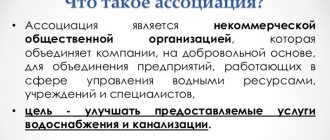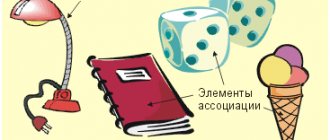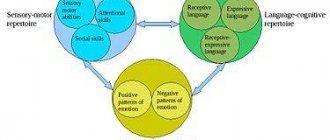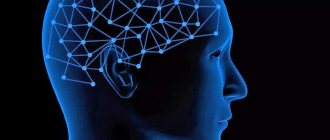The famous Italian writer Gianni Rodari compared the spoken word to a stone thrown into a pond. The circles diverging from it not only stirred up the water, they made completely unrelated objects move in the same rhythm: an autumn leaf on the water, a reed, a fisherman’s float, a water lily. The word we hear causes similar waves. Only these are waves of excitation diverging in the cerebral cortex. They involve thoughts, images, memories into movement. This is the process of the birth of associations, which play a very important role in the human psyche.
Associations from a psychological point of view
The concept of “association” was introduced by the English philosopher of the 17th century J. Locke, but the phenomenon itself has been known since Antiquity and was described by Plato and Aristotle.
Association as connection
Communication is how this concept is translated from Latin. It has many meanings, but in psychology this term refers to a spontaneous connection that occurs in the human brain between objects, phenomena of reality, memories and imaginary images. That is, such connections are caused by both external stimuli (words, smells, visual images, sounds, etc.) and information stored in memory.
The stimulus for the emergence of associations can also be internal processes in our organs. For example, heaviness in the stomach and heartburn instantly cause an association with a piece of fried fatty meat eaten at lunch.
Even your own thoughts can literally provoke a fan of associations. I think each of us has found ourselves in a situation where some random thought pulled out from the depths of our consciousness another thought that seemed unrelated to it. And that, in turn, grabbed a third, a fourth... And after some time we asked ourselves in surprise how our thoughts got here, why suddenly seemingly long-forgotten images were spinning in our heads.
Psychophysiological mechanism of associations
The basis of associations is a conditioned reflex reaction. Any sufficiently strong stimulus (word, image, smell, sound, thought) causes a focus of excitation in the cerebral cortex. This excitation along the nerve fibers from one neuron to another spreads in breadth and depth. Waves of excitation also capture new areas of the cortex, activate traces of previous foci of excitation, and evoke images, feelings, and ideas from memory. They are included in the thinking process and update new and new images.
The famous English creativity researcher T. Buzan compared associative thinking with fireworks. First, one sparkle-thought takes off, which explodes into dozens of new ones, and they, in turn, scatter in a fan of fiery splashes, covering the entire sky with a shining ball.
The process of creating associations is very important for the normal functioning of consciousness, for the effectiveness of our thinking and depends on the following factors:
- The speed of nervous processes, which also determines the speed of reflex reactions. This means the time and area of propagation of the nerve impulse. The higher the speed, the faster and more diverse associations arise.
- Memory and information stored in it. The more extensive and varied our knowledge, the richer the associations and, accordingly, the more original the products of thinking.
- Imagination. In the process of birth of associations, emerging images can be processed, transformed, and their elements can be combined in new combinations. This is how the imagination works, and the new images it creates enrich our memory and participate in thinking.
- The area of the subconscious. Associative processes, which are based on the spontaneous spread of excitation in the cerebral cortex, spreading deeper, connect the level of the subconscious to thinking. Since a huge amount of information that we are not conscious of is stored there, and there is no targeted access to it, associations are one of the few channels of communication with this mysterious level of the psyche.
Associations are individual in nature, as they are associated with experience and information stored in a person’s memory. However, there are also stable connections that are inherent in many people due to their common experience, interests, professional activities, etc. There is an interesting example or a kind of test. What association do you have with the word “undead”? Some people associate this concept with a gentle, affectionate attitude. And for those who are fond of books and films in the genre of mysticism and fantasy - with terrible supernatural creatures. There are even more universal associations, for example, snow in people’s minds is associated with winter, heat with summer, falling leaves with autumn.
Signs of violation
Scientists have identified some patterns of mental disorder. Violations in form are associated with a deviation in the associative process of thinking. Content violations include pathological judgments in the form of obsessions and delusions.
There are several types of disorders of this type of thinking.
- A change in the pace of the thought process can be associated with strong acceleration, noticeably faster than the speed of data processing, spasmodic generation of ideas and quick decision-making. Excessive acceleration is characteristic of manic states. In other cases, thinking can be very prolonged, and the event is thought about for a long time, the decision is made with difficulty. Sometimes extraneous thoughts involuntarily intrude and interfere with the normal thought process, leading astray from the desired topic. An unexpected stop in thinking may also occur, during which an involuntary break in current thoughts occurs.
- The mobility and liveliness of the thinking process can be complicated by an abundance of unnecessary minor details, clarification of the smallest details that are not essential for revealing the topic. The use of unnecessary, distracting associations interferes with normal thinking. The viscosity of thought leads to the loss of the essence of the conversation, the loss of its productivity.
- The grammatical construction of a text using stereotypical figures of speech, cliches, templates, and ready-made clichés deprives a person of the opportunity to think independently and expressively. The thought process is worsened by incoherent repetition of words, phrases, meaningless phrases and unnecessary sounds.
- Sometimes a failure occurs in the direction of goals. A person indulges in empty verbosity and begins an aimless rant. He can deviate from the topic, argue at length on an abstract association, then return again to the original postulate.
Some people present a simple idea in an overly ornate way. Sometimes the logic of thinking is violated or contradictory concepts are used.
Types of associations
The first known classification of associations was created by Aristotle, and we still use it. The ancient philosopher identified three types of connections:
- By similarity. In order for this connection to arise between two objects or phenomena in the human brain, they must be similar in some way: appearance, color, emotional impact, etc. Thus, the number 2 is associated with a goose, the sky with the ocean , and a snowy plain with a white sheet.
- By contiguity. This common type of connection occurs when we frequently perceive some objects at the same time. For example, the smell of pies can cause an association with home, with childhood, with an affectionate grandmother; the sound of the surf means happy holidays, and the aroma of tangerines and pine needles means happy New Year. This type also includes verbal associations born from set expressions. For example, in response to the word “willow”, many people will think of “weeping”, birch - white-trunked, oak - mighty, etc. But an association by contiguity can also reflect the presence of a real connection or interaction between objects. Thus, a hat is associated with the head, a cart with a horse, and the moon with the night.
- By contrast. This is the most complex type of association, difficult to explain. The image that appears in the mind causes an association with its opposite in meaning. So, if you say the word “day,” most people will remember night. Summer - winter, heat - cold. Such associations are the source of interesting vivid metaphors, for example comparing snowflakes to sparks.
Later, Aristotle's classification was supplemented by one more type. Associations by meaning are the result of the analysis of information and the emergence of complex logical and semantic connections in the human brain. They are largely individual and determined by personal experience, but there are also ones that are understandable to most people. For example, rain means a runny nose, the sea means an airplane. It is not difficult to establish a semantic connection between them.
Psychodiagnostic methods using associations
Since the beginning of the 20th century, connections spontaneously arising in the cerebral cortex have been used by psychologists to diagnose human mental states. S. Freud was the first to draw attention to the connection between free associations and processes occurring at the level of the unconscious. According to his theory, at this deep level of the psyche there are instincts and desires suppressed by a person, which contradict the requirements of society.
But having driven these forbidden desires into the far corner of the unconscious, a person did not get rid of them. They continue to influence his behavior, provoke phobias or strange behavior, and even cause mental disorders and organic diseases.
Free association method
Associations that arise involuntarily carry information about these suppressed desires and instincts, which allows a psychologist or psychiatrist to make a diagnosis. For this, S. Freud developed and began to use the method of free association, which to this day is one of the main ones in psychoanalysis.
The principle of this method is very simple. Having assumed a comfortable position and relaxed, the patient should simply say whatever comes to his mind. He can talk about his problems, or he can simply reflect on the meaning of life or discuss his colleagues. You need not to control, not to analyze, not to choose the right words, but to speak freely.
The patient’s thoughts and words themselves evoke different associations in his mind, generating a new stream of speech activity and pulling out from the unconscious what is hidden there and interferes with life. But the psychoanalyst must recognize the connection between individual phrases, words, and reservations of the patient and his psychological problems and complexes, identify these problems and reveal their essence to the client.
Variety of association methods
Currently, associative thinking is used in many psychodiagnostic techniques that make it possible to study the characteristics of an individual’s mental state, his problems, experiences and attitude towards others. Unlike Freud and his followers, representatives of other psychological movements prefer to use not free associations, but more organized and controlled by a psychotherapist. The methods are developed in such a way as to not only stimulate the emergence of associations, but also to be able to statistically process the results and compare them with data from other clients. All such diagnostic methods can be divided into three groups of tests:
- Based on verbal associations. In such tests, subjects are presented with a series of words or phrases, in response to which they must say the first thing that comes to mind. The very formulation, meaning, and scope of use of phrases are designed to reveal the internal problems of the person being diagnosed. One of the most popular such techniques is the “Paired Associations” test.
- Based on visual associations. Looking at the proposed pictures, often abstract, the client must say what they remind him of. The most famous of these techniques are the Rorschach Ink Blot Test and metaphorical cards.
- Based on the analysis of creative products. In order to study unconscious associations, the diagnosed person is asked to complete a creative task, for example, write an essay on a given topic or draw something. The creative process frees thinking and connects the subconscious to the process, which facilitates the birth of associations and opens access to archetype images, hidden desires and poorly understood problems.
Associative thinking is not only a source of important information about a person, it is a necessary condition for the intellectual and creative development of the individual.
Exercises for development
Thinking is a brain function that is subject to development and training. Systematic exercise improves the ability to think associatively. Children learn about their environment through associative thinking, which they need to further learn and perceive the world. It needs to be developed from infancy. A good associative thought process gives impetus to the emergence of original images and unusual ideas in children.
Kids easily generate new semantic connections. You can develop children's associative-figurative thinking in stages. First, the baby is introduced to objects and the actions associated with them. At the next stage, he is taught to generalize the concepts: dress, trousers, jacket, skirt - clothes; boots, sneakers, boots, slippers - footwear.
There are effective exercises. For example, a child is first asked about animals: what they do, what they eat, how they sleep and wash themselves. Then the child is offered to transform into a specific animal. Let the little man crawl on all fours, try to squeak, sniff and make sounds characteristic of this animal. A grown-up child must learn to make associative connections, find sequence in a series of words, and analyze objects based on their characteristics.
A negative reaction to associations can lead a child to develop various complexes. For example, negative emotions are caused by the associative series: injection - doctor - thermometer - vaccination. In such a situation, you need to set him up for the positive.
You need to patiently explain to the child that there is no need to be afraid of the injection, because it helps the person get rid of the disease. It is necessary to listen carefully to the baby’s associations, support him, reassure him and instill in him a sense of security.
In adults, associative series stimulate active thinking. Special training exercises help them remember new information better.
- You need to come up with 2 words that are logically unrelated to each other, and place associations between them, thus creating an associative chain. For example, “strawberries are money.” The following series may develop: strawberries - jam - store - seller - money.
- A long associative series is obtained by selecting an association for any word. For each subsequent word form, another associative word is selected. And this continues until the imagination runs out. All subsequent words must be somehow related to the initial unit of speech.
- You need to select two words, then find the associations that are common to them. For example, the words “berry”, “trees”, “grass”, “shrub”, “hazel”, “glade” are added to the concepts “green” and “forest”. Both originally intended definitions apply equally to any of these words.
- Searching for unusual associations is a great way to train mental activity. For example, everyone knows that printed publications are stored in a bookcase. Expected associations: encyclopedia, collections of poetry, magazines, fiction. But you can come up with an unusual range: plates, souvenirs, jewelry, toys, stationery, radio.
- It is recommended to mentally transform the scribbles depicted on the piece of paper into specific images. Droodle pictures are popular. They initially contain several options for perception, so there is the possibility of using multiple interpretations. Solving such pictures perfectly develops associative thinking.
- Group exercises involve coming up with concepts one by one while building an associative chain. Words can be selected thematically. The following task may involve indirect associations. After drawing up the chain, you need to conduct an analysis and exchange of opinions. All participants must explain why they said this particular word.
Such exercises help you understand your own emotions, experiences and fears.
Rules
When performing exercises, you must adhere to the following basic rules:
- associations should not be repeated, each word is used once during the game;
- it is necessary to search for original associations, therefore it is necessary to avoid template words and superficial concepts;
- during a hitch, you need to slowly say the previous word out loud, imagine an image and try to evoke associations through it;
- the search for associations must be accompanied by certain sensations in the body, since the bodily reaction contributes to the birth of the most interesting association.
Execution frequency
You need to exercise daily. Good results are obtained by performing various exercises from 1.5 to 2 hours a day. Start training gradually. At first, compiling associative series can take 20 minutes a day. Then the time increases.
Associations in thinking and creativity
Cognitive processes in general have a lot to do with associations. For example, our memory. It is the emergence of a connection between newly received information and what is stored in the brain that ensures quick and easy memorization. The greater the volume of a person’s knowledge, the more diverse associations arise and the more effective the memorization process.
The associative nature of thinking provides the ability to connect information from many areas of life and stored at different levels of consciousness to solving problems. The rapid emergence of connections between images, concepts, and thoughts makes the imagination free and easy, and the emerging ideas become original and non-standard.
Obviously, the creative process presupposes the presence of developed associative thinking. One of its features is that this thinking works, as it were, bypassing logic. After all, associations arise spontaneously and do not require building complex logical chains of cause-and-effect relationships. Often the associations that arise seem illogical, but they have a deep meaning and allow you to see workarounds in solving the most difficult problems.
Now psychologists have developed many methods and trainings for the development of associative thinking, as well as techniques that allow you to learn how to manage the process of creating associations, make it conscious and include it in the creative process.
Links[edit]
- Dictionary.com
- 21st Century Lexicon Dictionary.com
- Gough, Harrison G. Studying creativity using word association tests.
Journal of Applied Psychology, Vol. 61(3), June 1976, pp. 348-353. - ↑
Vance Packard,
"Hidden Persuasions"
, Penguin, 1961 paperback edition, page 129 - Jung, Carl G. (1910). "Method of association". American Journal of Psychology
.
21
(2):219–269. DOI: 10.2307/1413002. Retrieved November 16, 2013.









